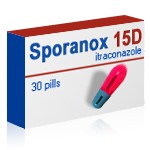Understanding Internal Fungal Infections and How to Treat Them


Fungal infections are commonly associated with superficial conditions such as athlete’s foot, ringworm, or thrush. However, under certain circumstances, fungi can invade deeper tissues and organs, resulting in systemic or invasive fungal infections that can be life-threatening. These infections often go unnoticed in early stages and are typically seen in individuals with weakened immune systems. Understanding how fungal infections affect internal organs, what causes them, and how they are treated is essential to ensuring timely diagnosis and effective therapy. One such medication that plays a critical role in the management of these infections is Sporanox.
What Is a Fungal Infection That Affects Internal Organs?
A fungal infection that invades the internal organs is known as a systemic or invasive fungal infection. Unlike common skin or mucosal infections, these occur when fungi enter the bloodstream or lungs and disseminate to vital organs such as the liver, kidneys, brain, heart, or spleen. This type of infection is far more serious and requires aggressive medical intervention.
The fungi responsible for internal infections are often opportunistic pathogens, meaning they take advantage of a compromised immune system. Among the most common organisms implicated are Candida, Aspergillus, Histoplasma, Cryptococcus, and Blastomyces. Depending on the route of entry and the specific pathogen involved, the infection can begin in the lungs (through inhalation of spores), the gastrointestinal tract, or via direct bloodstream invasion, particularly in hospital settings.
Invasive candidiasis is one of the most prevalent forms of internal fungal infection. It occurs when Candida species enter the bloodstream, usually through intravenous lines or catheters, and spread throughout the body. Similarly, Aspergillus species can cause pulmonary aspergillosis, which may evolve into invasive aspergillosis, particularly in immunocompromised individuals such as cancer patients or organ transplant recipients.
What Are the Symptoms of Internal Fungal Infection?
Symptoms of internal fungal infections can vary widely depending on the organ system affected, the type of fungus involved, and the patient’s overall health status. Unlike surface fungal infections, which often present with obvious signs like itching or redness, systemic fungal infections often have non-specific symptoms, making them difficult to diagnose in the early stages.
Fever is one of the most common symptoms, especially a persistent fever that does not respond to antibiotics. Chills, night sweats, and fatigue are also common, as the body attempts to fight off the invading pathogen. If the infection involves the lungs, symptoms might include cough, chest pain, and shortness of breath. In cases where the brain is affected, neurological symptoms such as headaches, confusion, and even seizures may appear. When the liver or spleen is involved, abdominal pain and hepatosplenomegaly may occur.
One of the challenges in diagnosing systemic fungal infections is that the symptoms often mimic bacterial or viral infections. As a result, the diagnosis may be delayed unless there is a high index of suspicion, particularly in at-risk populations. Advanced imaging, blood cultures, tissue biopsies, and fungal antigen tests are often required to confirm the diagnosis and identify the specific pathogen.
What Causes Fungal Infection Inside the Body?
Internal fungal infections usually occur when the body's natural defenses are compromised. The immune system plays a central role in controlling the growth and spread of fungi, and when it becomes weakened—either through illness, medication, or medical procedures—fungi can grow unchecked and invade internal organs.
One major risk factor is immunosuppression. Individuals undergoing chemotherapy for cancer, those receiving immunosuppressive therapy following organ or bone marrow transplantation, and people with advanced HIV/AIDS are at particularly high risk. These patients lack the immune capacity to fight off fungi that would otherwise be harmless in a healthy individual.
Another cause is the prolonged use of antibiotics, which can disrupt the normal microbial balance in the body. By killing off beneficial bacteria, antibiotics can allow fungi, particularly Candida, to overgrow and eventually invade the bloodstream. Similarly, invasive medical devices like central venous catheters, urinary catheters, or endotracheal tubes can provide a direct entry point for fungi into the bloodstream or internal organs.
Hospital environments are another common setting for acquiring internal fungal infections, particularly in intensive care units. Here, patients are more likely to be critically ill, intubated, or undergoing complex surgeries, all of which increase the risk of fungal invasion.
Environmental exposure can also be a factor. Fungi such as Histoplasma or Blastomyces are found in soil and can be inhaled, particularly in individuals involved in construction, farming, or outdoor activities in endemic areas. These fungi can then travel from the lungs to other organs, causing systemic infection.
What Are Four Diseases Caused by Fungal Infections?
There are several serious diseases that result from internal fungal infections, and among the most notable are:
- Invasive Candidiasis – Caused by Candida species, this infection can affect the blood, heart, brain, eyes, and other organs. It is a leading cause of fungal sepsis in hospitalized patients.
- Aspergillosis – Primarily caused by Aspergillus fumigatus, this condition often starts in the lungs but can spread to the brain, kidneys, and skin. It is commonly seen in patients with neutropenia or who have undergone bone marrow transplantation.
- Histoplasmosis – Caused by Histoplasma capsulatum, this infection starts in the lungs and can disseminate to other organs, particularly in people with weakened immunity. It is endemic to certain regions of the Americas.
- Cryptococcosis – A severe fungal infection caused by Cryptococcus neoformans, it often affects the brain and spinal cord, leading to cryptococcal meningitis. It is frequently seen in individuals with AIDS or other immunocompromised states.
These diseases often require long-term antifungal treatment and careful monitoring due to their potential severity and high mortality rates if left untreated.
The Role of Sporanox in the Treatment of the Condition
Sporanox, also known by its generic name itraconazole, is a potent antifungal medication that plays a crucial role in treating various types of internal fungal infections. It belongs to the class of drugs known as triazole antifungals, which work by inhibiting the synthesis of ergosterol, an essential component of fungal cell membranes. Without ergosterol, fungal cells become structurally unstable and die off.
Sporanox is particularly effective against a broad spectrum of fungi, including Candida, Aspergillus, Histoplasma, Blastomyces, and Cryptococcus. It is often prescribed as a first-line or alternative treatment for systemic fungal infections, especially in patients who are unable to tolerate other antifungals like amphotericin B.
One of the advantages of Sporanox is its oral formulation, which allows for outpatient treatment in stable patients. It is also available in capsule and oral solution forms, providing flexibility in administration. The medication is commonly used for the long-term management of chronic fungal infections such as histoplasmosis and aspergillosis, and may also be used prophylactically in immunocompromised individuals to prevent fungal infections.
However, Sporanox is not without side effects. Common adverse reactions include gastrointestinal upset, rash, and headache. More serious effects can include liver toxicity and congestive heart failure in predisposed individuals. Because of this, liver function tests are typically monitored during long-term therapy. Sporanox also has numerous drug interactions, particularly with medications metabolized by the cytochrome P450 system, so a thorough medication review is essential before prescribing.
Despite these concerns, Sporanox remains a cornerstone in the treatment of systemic fungal infections. It provides an effective, less toxic alternative to intravenous antifungals and can be used in both acute and chronic settings.
Conclusion
Fungal infections of the internal organs are serious and potentially life-threatening conditions that require timely diagnosis and appropriate treatment. While they are more common in individuals with weakened immune systems or those exposed to invasive medical procedures, awareness of the risk factors and symptoms can lead to earlier intervention and better outcomes.
The complexity of these infections — ranging from candidiasis and aspergillosis to histoplasmosis and cryptococcosis—necessitates a careful and targeted therapeutic approach. Sporanox has proven to be an effective and versatile antifungal agent in managing many of these conditions, offering a valuable option in both treatment and prevention.
Through continued research, improved diagnostics, and expanded access to antifungal medications, the burden of invasive fungal infections can be reduced. For those at risk or currently living with such infections, understanding the disease and available treatments like Sporanox can be a vital step toward recovery and long-term health.
Medically Reviewed by Dr. Mevan Nandaka Wijetunga, MD
(Updated at Jun 14 / 2025)

